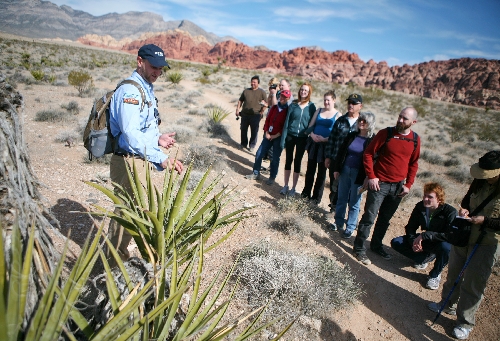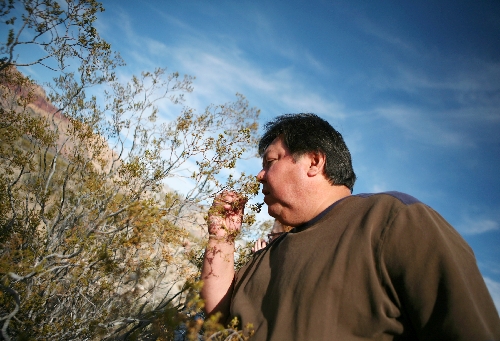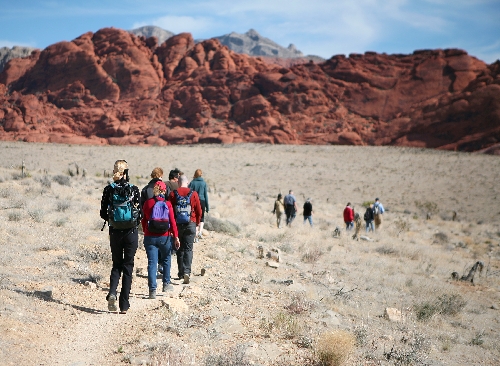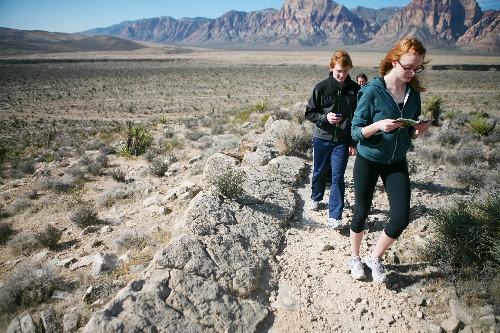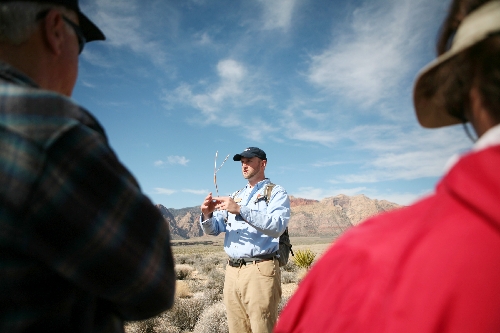Hikers learn about plants’ medicinal uses at Red Rock Canyon
From heart medication to the cure for the common headache, the building blocks for modern medicine can be found in nature.
The Red Rock Canyon Interpretive Association offers a new hike detailing this fact, Medicinal Plants of the Moenkopi.
The addition of the hike to the roster is credited to Aaron Leifheit, environmental education specialist. This day, March 14, 15 people participated.
"Almost every medicine you've ever taken comes from nature," Leifheit told the hikers. "Somewhere out here in a tiny crack high in those mountains is some plant that only 50 ... people know the name of, but it could be the next life-saving drug."
The hikers did not try to locate that plant in the high mountains, but instead they stuck close to the visitor center for an easy two-mile hike.
First on the tour was the creosote bush. The most common plant in the Mojave Desert, it's known for its pungent smell and resinous, waxy coating of the leaves. Native Americans knew of its bacteria-fighting properties, Leifheit told those gathered around, and used it on wounds and for cleansing, while conserving water.
"The Native Americans used it to bathe, which sounds kind of weird, but after a really hard day, you start a fire, and you put some of the creosote on there, and all that smoke that goes over your body, it will kill the bacteria on it," Leifheit said.
The willow was next on the lineup. Leifheit demonstrated its flexibility, bending it this way and that. It always returned to its original shape without snapping. It's a characteristic that makes it useful for weaving into baskets, animal traps and cradle boards for carrying babies. The bark of the willow contains the root chemical of aspirin, he said.
Leifheit was quick to point out that it would require a long process to derive the pain-killing properties from it and that "there are lots of plants out here with (medicinal properties), but there are also lots of supplement and herbal stores in town where you can get the same stuff."
At each stop, Leifheit and his colleague, Jennifer Vincent, an interpretive naturalist, encouraged the hikers to touch and smell the plants.
"We really want to keep it interpretive and with conservation in mind," Vincent said of the intent of the new hike. "We don't want people to think they can come pick the plants."
As the hike continued, Leifheit pointed out the erodium cicutarium, more commonly known as redstem filaree. Some people view it as a weed, he said, but it has antioxidant properties and is full of vitamins.
The plants developed medicinal properties for their own survival, Leifheit said. By being distasteful, or by having anti-bacterial chemicals to block fungus, they had a better chance of survival.
Some are more distasteful than others. The almond brush gives off the scent of almond, but it contains cyanide.
"So, if your wife tries to poison you, this would be the plant she'd use," said hiker Bob Davidson.
Julie Doyle lives in The Lakes area. She's been on Red Rock Canyon's trails many times on her own. She started taking the hikes offered through the Interpretive Association only around the first of the year. Since then, she said she signs up for two or three guided hikes a month.
"Now, I see so much more than I'd seen before," she said. "I've done a lot of the geology one. It's so informative, and they give you all these handouts. You really start to understand all these layers."
Dianne Sperry and her husband, Steve, live at the Summerlin gateway to Red Rock Canyon and are frequent visitors. She learned of the hike and decided to sign up while Steve was away on business.
"It sounded like such a treat, so relaxing," she said. "Besides, I didn't want to hike alone."
The hike began in the early morning. As the day warmed, hikers took off their jackets. The trail began in the wash near the visitor center. It continued up a ridge, stone making for a natural walkway. It was the only challenging part of the hike. The effort was rewarded with a panoramic view.
Illustrated reference guides were shared to learn more.
Not all the plants had medicinal value. The fibers of the yucca was used by Native Americans for making belts, sandals and rope. The desert trumpet's tube structure was used to suck up water from rock pools. The branch that Leifheit passed around resembled an insect.
"I always show these to kids, and they geek out," he said.
The Interpretive Association plans three more Medicinal Plants of the Moenkopi hikes for April 11, May 30 and June 20. Reservations are required by calling 515-5367.
Contact Summerlin/Summerlin South View reporter Jan Hogan at jhogan@viewnews.com or 387-2949.
Medicinal Plants of the Moenkopi hikes
The Red Rock Canyon Interpretive Association plans to host three more Medicinal Plants of the Moenkopi hikes, which are planned for April 11, May 30 and June 20. Reservations are required by calling 515-5367.



